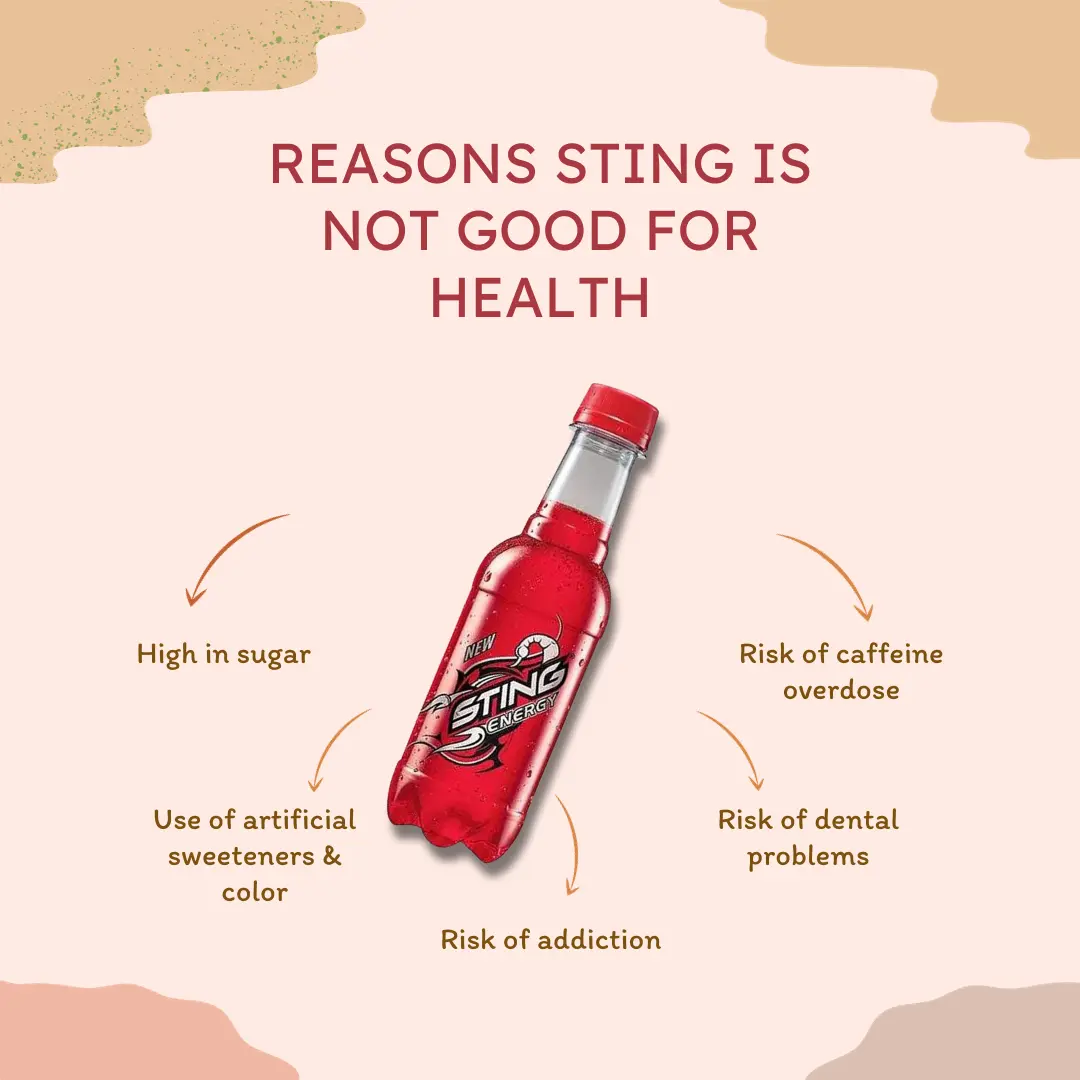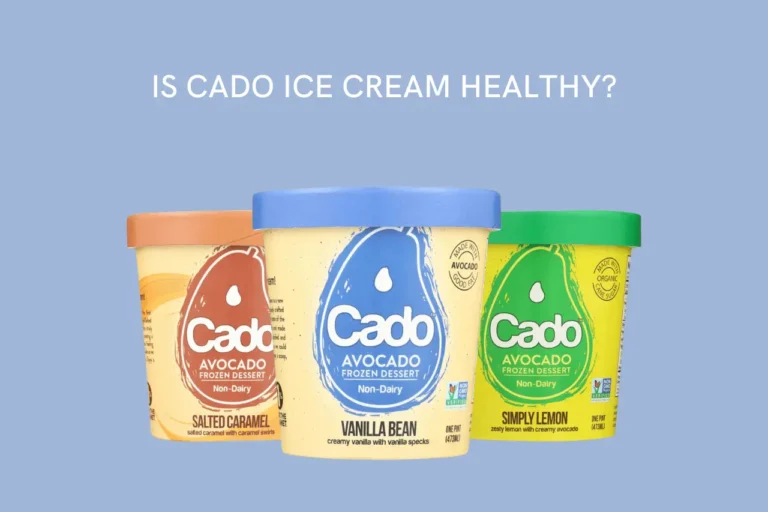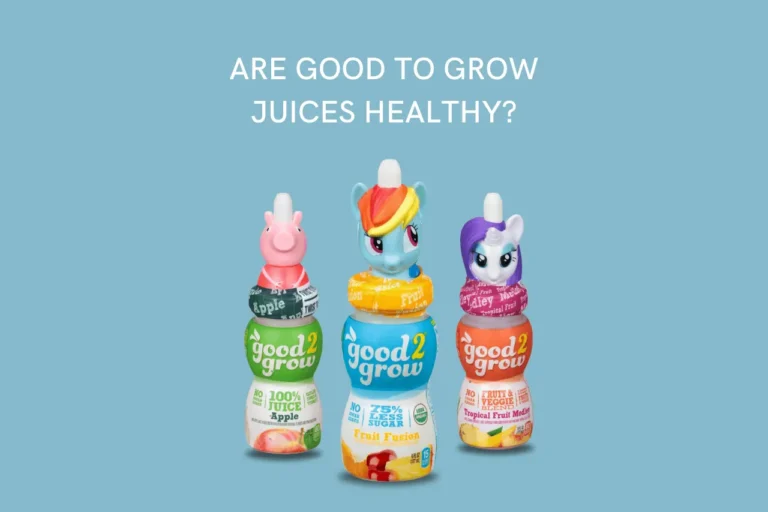Sting is one of the most popular brands of caffeinated energy drinks manufactured and marketed by PepsiCo.
It is one of the most affordable and fastest-growing energy drinks in India. This has led to the coming of different flavors of Sting energy drink.
It is known for providing a boost of energy and increased alertness due to its high caffeine content.
However, is Sting energy drink good for health?
Short answer: Sting energy drink is not good for health, and consuming it in excess can lead to many side effects such as weight gain, obesity, diabetes,
In this post, I have listed 6 major side effects of the Sting energy drink that everyone should know.
However, first, let’s start with the ingredients in it.
Also read: Is Breezer Good For Health? All You Need To Know
What are the ingredients in Sting energy drink?
Sting energy drink is made from Carbonated water and Sugar as the primary ingredients.
It also includes other ingredients such as Acidity regulators (330,331), Sequesterants (452(i), 385), Taurine, Caffeine, Preservatives (211, 202), Sweeteners(955, 950), inositol, Vitamins premix, Artificial color(129) and flavors.
Let’s know about each of the ingredients to understand them better.
- Carbonated water: The base of Sting energy drink is carbonated water, which gives it a refreshing fizz (like Cola or Pepsi) and enhances the overall drinking experience.
- Sugar: It’s one of the primary ingredients that adds sweetness to Sting and provides a quick energy boost.
- Acidity regulators(330, 331): These acidity regulators, also known as citric acid (330) and sodium citrate (331), help to balance the pH levels in the Sting.
- Sequestrants(452(i), 385): Sequesterants, such as disodium phosphate (452(i)) and calcium disodium EDTA (385), are added to improve the quality and stability of the drink.
- Taurine: It is an amino acid naturally found in the body and is often included in energy drinks. It supports cognitive function and helps reduce feelings of tiredness.
- Caffeine: It is one of the key ingredients in Sting that provides a temporary boost in energy and helps to improve focus and alertness.
- Preservatives(211, 202): Preservatives, such as sodium benzoate (211) and potassium sorbate (202), are added to prevent the growth of bacteria and molds, ensuring the product remains safe for consumption over an extended period.
- Artificial sweeteners: Apart from sugar, artificial sweeteners such as sucralose (955) and Acesulfame potassium (950) are used to sweeten Sting.
- Inositol: It is a naturally occurring compound that helps to regular serotonin levels. Serotonin is a key hormone that controls your mood, feelings, and happiness.
- Vitamins premix: Sting energy drink incorporates a premix of vitamins, such as niacin (B3), pyridoxine (B6), and cobalamin (B12).
- Artificial color(129): To give Sting its vibrant red hue, an artificial color known as Red 129 is used.
The ingredients in Sting energy drink are not good as it contains sugar, artificial sweeteners, colors, and flavors. If consumed in excess, it can result in unwanted health issues.
Nutritional value of Sting energy drink
Sting energy drink is high in sugar, zero in fat and protein, and contains sodium and some B vitamins such as B3, B6, and B12.
A 100ml serving of Sting energy drink provides:
- Calories: 28
- Carbohydrates: 7g
- Sugar: 7g
- Fat: 0g
- Protein: 0g
- Sodium: 53mg
- Vitamin B3: 1.9mg
- Vitamin B6: 0.2mg
- Vitamin B12: 0.2mcg
How much caffeine does the Sting energy drink have?
Caffeine is one of the most important ingredients in a Sting energy drink that gives you that feeling of increased alertness and wakefulness.
It works by blocking the action of adenosine, a neurotransmitter that makes you feel tired and sleepy.
This increases the activity of other neurotransmitters, such as dopamine and norepinephrine, making you more alert. It also increases the release of adrenaline, which further enhances alertness.
A 250ml bottle of Sting energy drink contains 72mg of caffeine, slightly less than red bull, which has 80 mg of caffeine.
The caffeine content in Sting energy drink is considered accurate for providing a boost while reducing the risk of caffeine overdose and addiction.
According to the FDA, healthy adults can consume 400mg of caffeine daily, equivalent to 5 to 6 bottles of Sting energy drink.
But should you drink this much of Sting? Absolutely not.
Also, remember that if you’re pregnant or breastfeeding, you shouldn’t consume Sting Energy Drink. It’s also be avoided if you’re under 18 or caffeine-sensitive.
If you want to learn more about caffeine, you can check out this video.
6 Side effects of Sting energy drink
1. High in sugar
Sting energy drink is high in sugar containing 17.5g per 250ml or one bottle serving.
According to the American Heart Association, men should limit their daily sugar intake to 36g, while women to 24g.
Consuming just a single 250ml bottle of Sting energy drink provides 48% of the daily sugar limit for men and 72% for women.
This is a significant amount of daily sugar.
Consuming too much sugar can lead to serious side effects such as weight gain, obesity, risk of diabetes, cancer, depression, and aging.
2. Risk of caffeine overdose
Even if the daily caffeine limit is 400mg, that doesn’t mean you will only stop caffeine consumption after reaching this value.
Consuming even 200mg of caffeine daily can make you addicted or dependent on caffeine.
The risk of overdosing on caffeine increases when consumed in energy drinks. This is because energy drinks often contain high levels of caffeine, and your body builds up a tolerance to the caffeine over time.
As you consume more and more energy drinks, your body becomes used to the high levels of caffeine and sugar, and 1 or 2 servings no longer have the same effect as they did in the beginning.
This can lead to consuming too much caffeine.
Caffeine overdose can lead to various side effects, such as
- Nervousness.
- Shakiness.
- Anxiety.
- Confusion.
- Irregular heartbeats.
- Panic attacks.
- Calcium deficiency.
3. Use of artificial sweeteners
Sting energy drink is high in sugar, and adding artificial sweeteners makes it even more unhealthy.
While the sweeteners used in it have been deemed safe by food authorities, consuming too much of these raises the risk of various health problems.
For those who don’t know, artificial sweeteners are food additive that duplicates the sweetness of sugar with fewer calories.
As per studies, consuming too much artificial sweeteners can have many side effects, such as weight gain, brain tumors, bladder cancer, etc.
It’s best to limit your food intake that contains artificial ingredients.
4. Risk of weight gain
While energy drinks are associated with increased energy levels, they are also associated with an increased risk of weight gain.
And that’s because they are high in sugar.
In fact, the combination of high sugar, artificial sweeteners, and artificial flavors in the Sting regularly can also lead to obesity in the long run.
The risk increases more for people who are not active enough and consume sugar-filled foods more often.
5. Dental problems
Because Sting energy drink is loaded with sugar, many dental experts believe it may affect your dental health.
Sugar in it can wear down the tooth enamel, exposing them to cavities, hypersensitivity, and erosion.
6. Risk of addiction
While the jury is still out on whether energy drinks are good for you, one thing is for sure – they are addictive. In fact, they are made to be addictive.
And, like any other addiction, there are risks associated with energy drink addiction.
Sting energy drink addiction can lead to consuming too much of it, which can result in various side effects such as:
- Increased heart rate and blood pressure.
- Insomnia.
- Nervousness.
- Headaches.
- Dehydration.
- Gastrointestinal problems.
- Weight gain or obesity.

Are there any benefits of Sting energy drink?
While Sting energy drink has plenty of side effects, it also has some benefits, such as
- It increases your focus and energy levels.
- It improves your mood.
- It provides a refreshing effect.
- It is one of the most affordable energy drinks on the market.
- It is lower in calories than other energy drinks.
Note that most of the Sting energy drink benefits may be desirable only in certain situations. And it’s important to consume(if you want) in moderation.
Moreover, the Sting energy drink boosting effects are temporary.
Once they wear off, you’ll start to feel low again and need another bottle of Sting energy drink.
This may increase the risk of overdosing with caffeine and sugar.
Does Sting energy drink contain alcohol?
Sting energy drink is a non-alcoholic beverage.
It is primarily made up of carbonated water and sugar.
Is Sting energy drink better than Charged energy drink?
As soon as Sting energy drink came on the market, it became a hit among people. As a result, Thums Up also introduced their energy drink called Charged.
However, when compared, which one is better?
The answer is Sting.
Why?
- Sting has slightly more caffeine than Charged.
- Sting has additional energy-boosting ingredients such as Taurine and Inositol.
- Sting has less calories and sugar than Charged.
- Sting has added B vitamins, while Charged doesn’t.
However, Charged does not contain artificial sweeteners.
In short, Sting will provide you with more energy because of its higher caffeine content and additional energy-boosting ingredients.
On the other hand, if you prefer a drink without artificial sweeteners and are not concerned about high sugar and added vitamins, Charged could be a suitable option.
Note that whether you choose Sting or Charged, it’s important to consume them in moderation and not regularly.
How much Sting energy drink should one drink in a day?
One should consume no more than one serving(250ml) of the Sting energy drink in a day.
Although, most experts believe one can drink 500ml of the energy drink daily.
However, if you consumed 2 bottles or 500ml of Sting energy drink in a day, that would provide you with 35g of sugar, which is almost 100% of the daily sugar limit.
You must keep your daily intake to a minimum and only drink when necessary, such as while playing sports or doing energy-intensive tasks.
Final words
While Sting energy drink may satisfy your taste buds and provide a temporary energy boost, it is not good for your health.
In fact, if consumed in excess or regularly, Sting energy drink can lead to various side effects such as weight gain, obesity, diabetes, caffeine addiction, and dental problems.
To stay energized, eat well, exercise regularly, and get enough sleep.
Found this information helpful? Share it.
Here are a few other posts that might also be helpful for you.
- Is Charged Energy Drink Good For Health? Here’s The Truth
- Is Parle G Good For Your Health? The Answer Might Surprise You
- Is Maggi Good For Your Health? Here’s What Research Says
- Is Bournvita Good For Health? Find Out Here
FAQs
People have reported experiencing heartburn after drinking Sting energy drink. This is likely because the stomach produces acid to compensate for the high levels of caffeine in Sting.
The bottle does not specify an age limit, but it does state that it should not be consumed by children. So, if you are under the age of 18, you should avoid consuming Sting or any other energy drinks.
Sting energy drink should not be consumed by anyone under the age of 18, pregnant or breastfeeding women, caffeine-sensitive individuals, people with health issues, or those taking medications.




